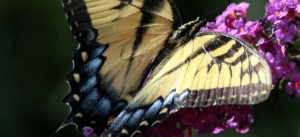THE BUTTERFLY EFFECT: LED TECHNOLOGY
A relatively new and very clever method of delivering LED light has been inspired by a very unlikely source: a butterfly. NaturalNews reports, “The science behind higher-emission light emitting diodes (LED) comes from the fluorescent patches found on the wings of the African swallowtail butterfly.” This new method lends itself to emitting even brighter light than traditional LED technology.
It is actually the structure and scales of the butterfly’s wing that stirred the improvement. African swallowtail butterfly’s scales mimic photonic crystals that provide intense fluorescent light. The scales contain mirrors underneath them which direct light. The pigment in their wings actually absorbs ultra-violet light and releases it as a bright blue-green shade which they use to communicate with one other.
NaturalNews explains, “For the LEDs, scientists at MIT used actual photonic crystals to get the same effect. A lattice design etched into the crystals, implanted in the upper levels of LED’s design, makes the light emitted shine brighter.” This advancement sets the stage for LED light to replace incandescent light bulbs. LEDs are very energy efficient so such a transition would make economical sense and benefit our environment.






